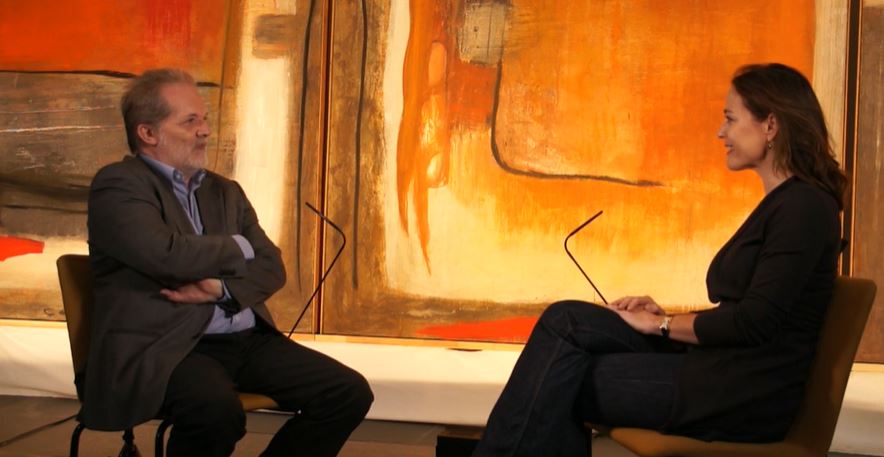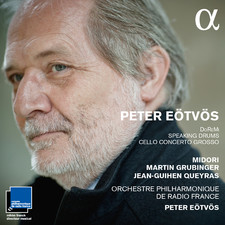Cello Concerto Grosso
for Violoncello and Orchestra
Commissioned by Stiftung Berliner Philharmoniker, Tonhalle Zürich, Bergen Filharmoniske Orkester,
Toronto Symph. Orch., Seoul Phil. Orch.
Description
First performance: 16 June, 2011, Berlin, Philharmonie
Berliner Philharmoniker
Conductor: Peter Eötvös
Miklós Perényi, violoncello
The work is a dialogue in multiple levels: The solo cellist performs with the orchestral cello section, and soloist and cello section both enter into dialogue with the whole orchestra. The concerto retains the classical form of three-movements which could be characterised as ‘energetic, dance-like’, ‘meditative’ and ‘fresh and sparkling’. The music also cites instrumental techniques of Transylvanian folk music such as the ‘Bartók pizzicato’ with its cracking percussive sound.
/Peter Eötvös/
Synopsis
The meaning of a Concerto Grosso refers to not only one but a whole group of soloists who are competing with the orchestra. The double title ‘Cello Concerto Grosso’ refers to the orchestral set as besides the 8 cellist ( concertino ) I integrated a soloist as a ‘fore dancer’ .
My concerto is a series of short dance-acts, it well may be that the “last dance” is coming from a traditional Transylvanian culture which is doomed to a slow disappearance….
Luckily about a decade ago Béla Bartók and László Lajtha were collecting and noting down the music of these dances, which explain us how they were playing these instrumental dances traditionally.
Since my oratorium ‘Atlantis’ I was using these special Transylvanian rhythm in some of my compositions, this characteristic melody form.
A quiet sadness is always present as this may be the last time that we’re dancing together.
For these special play-techniques not only the Bartók Pizzicato (clashing pluck sounds) belongs to, but also the dance-like breezy Glissandos, which refers to that these dance music were often played on string instruments.
In this Concerto 3 dance-situations are rotating: men’s throbbing with their legs slowly, women’s slow floating dance, and their joint dance which is torn apart from time to time as many of them don’t know the moves anymore….
/Peter Eötvös/
Performances
Eötvös: Cello concerto grosso
Sung-Won Yang (violoncello)
Bremen Philharmonic Orchestra
Bremen Philh.
Pannon Philharmonic Orchestra
Sung-Won Yang, cello
Program:
Eötvös: Sirens' Song, Cello Concerto Grosso
Bartók: Four orchestra pieces op. 12. ; Cantata profana
Conductor: Peter Eötvös
MÜPA
Eötvös: Sirens' Song, Cello Concerto Grosso
Cello Concerto Grosso: Sung-Won Yang
Conductor: Peter Eötvös
Pannon Philharmonic Orchestra
MÜPA
Pannon Philharmonic Orchestra
Sung-Won Yang, cello
Conductor: Peter Eötvös
Program:
Eötvös: Sirens' Song; Cello Concerto Grosso
Bartók: Four orchestra pieces op. 12. ; Cantata profana
Eötvös: Sirens' Song, Cello Concerto Grosso
Cello Concerto Grosso:
Sung-Won Yang, cello
Conductor: Peter Eötvös
Pannon Philharmonic Orchestra
Eötvös: Cello Concerto Grosso
István Várdai, violoncello
Conductor: Róbert Farkas
MÁV Symphony Orchestra
Academy of Music
More info >
Eötvös: Gliding of the eagle in the skies, Cello concerto grosso, Alle vittime senza nome
Cond.: Peter Eötvös
Gothenburg Orchestra
Gothenburg Symphony Orchestra
Eötvös: Gliding of the eagle in the skies
Eötvös: Cello concerto grosso
Eötvös: Alle vittime senza nome
Bartók: Miraculous Mandarin
Cond: Peter Eötvös
Eötvös: Gliding of the eagle in the skies, Cello concerto grosso, Alle vittime senza nome
Cond.: Peter Eötvös
Gothenburg Orchestra
Gothenburg Symphony Orchestra
Eötvös: Gliding of the eagle in the skies
Eötvös: Cello concerto grosso
Eötvös: Alle vittime senza nome
Bartók: Miraculous Mandarin
Cond: Peter Eötvös
Eötvös: Cello Concerto Grosso, Speaking drums, DoReMi
Eötvös: Cello Concerto Grosso (Jean-Guihen Queyras, vcl)
Eötvös: Speaking drums (Martin Grubinger, percussion)
Eötvös: DoReMi (Goto Midori, vl) - French premiere
Boulez: Notations
Conductor: Peter Eötvös
Orchestre Philharmonique de Radio France
Auditorium de Radio-France
Orchestre Philharmonique de Radio France
Eötvös: Cello Concerto Grosso (Jean-Guihen Queyras, vcl)
Eötvös: Speaking drums (Martin Grubinger, percussion)
Eötvös: DoReMi (Goto Midori, vl) - French premiere
Boulez: Notations
Conductor: Peter Eötvös
Auditorium de Radio-France
Eötvös: Cello Concerto Grosso
International Bartók Festival
Savaria Symph. Orchestra
Miklós Perényi, vcl, cond. Gregory Vajda
Orchestre Philharmonique de Monte Carlo
Eötvös: zeroPoints
Eötvös: Cello Concerto Grosso (Eric-Maria Couturier, vcl)
Kurtág: Messages
Kodály: Háry suite
Conductor: Peter Eötvös
Eötvös: zeroPoints, Cello Concerto Grosso
Eötvös: zeroPoints
Eötvös: Cello Concerto Grosso (vcl. Eric-Maria Couturier)
Kurtág: Messages
Kodály: Háry suite
Conductor: Peter Eötvös
Orchestre Philharmonique de Monte Carlo
Eötvös: Cello Concerto Grosso
ORF Radio-Symphonieorchester Wien,
violoncello: Sung-Won Yang
conductor: Johannes Kalitzke
Musikverein, Vienna
Eötvös: Cello Concerto Grosso
Bratislava Orchestra
Vcl: Miklós Perényi
Seoul Philharmonic Orchestra
Seoul Music Festival
Ligeti: Concert Romanesc
Eötvös: Cello Concerto Grosso (Sungwon Yang, violoncello)
Kurtag: New messages for orchestra
Bartók: Piano concerto No 2 (Sunwook Kim, piano)
Cond: Peter Eötvös
Seoul Arts Center
Eötvös: Cello Concerto Grosso
Seoul Music Festival
Ligeti: Concert Romanesc
Eötvös: Cello Concerto Grosso (Sungwon Yang, violoncello)
Kurtag: New messages for orchestra
Bartók: Piano concerto No 2 (Sunwook Kim, piano)
Cond: Peter Eötvös
Seoul Philharmonic Orchestra
Seoul Arts Center
Bergen Philharmonic Orchestra
Bergen Festival
Eötvös: Cello Concerto Grosso
Miklós Perényi, violoncello
Cond: Peter Eötvös
Eötvös: Cello Concerto Grosso
Bergen Festival
Miklós Perényi, violoncello
Cond: Peter Eötvös
Bergen Philharmonic Orchestra
Bergen Philharmonic Orchestra
Bergen Festival
Eötvös: Cello Concerto Grosso
Miklós Perényi, violoncello
Cond: Peter Eötvös
Eötvös: Cello Concerto Grosso
Bergen Festival
Miklós Perényi, violoncello
Cond: Peter Eötvös
Bergen Philharmonic Orchestra
Toronto Symphony Orchestra
New Creations Festival
Eötvös: zeroPoints
Eötvös: Cello Concerto Grosso
Joseph Johnson, violoncello
Cond: Peter Eötvös
Eötvös: zeroPoints, Cello Concerto Grosso
New Creations Festival
Joseph Johnson, violoncello
Cond: Peter Eötvös
Toronto Symphony Orchestra
Tonhalle Zürich
Liszt: Mephisto Waltz
Eötvös: Violoncello concerto grosso
Bartók: Concerto for orchestra
Cond: Peter Eötvös
Eötvös: Cello Concerto Grosso
Liszt: Mephisto Waltz
Eötvös: Violoncello concerto grosso
Bartók: Concerto for orchestra
Cond: Peter Eötvös
Tonhalle Zürich
Tonhalle Zürich
Liszt: Mephisto Waltz
Eötvös: Violoncello concerto grosso
Bartók: Concerto for orchestra
Cond: Peter Eötvös
Eötvös: Cello Concerto Grosso
Liszt: Mephisto Waltz
Eötvös: Violoncello concerto grosso
Bartók: Concerto for orchestra
Cond: Peter Eötvös
Tonhalle Zürich
Tonhalle Zürich
Liszt: Mephisto Waltz
Eötvös: Violoncello concerto grosso
Bartók: Concerto for orchestra
Cond: Peter Eötvös
Eötvös: Cello Concerto Grosso
Liszt: Mephisto Waltz
Eötvös: Violoncello concerto grosso
Bartók: Concerto for orchestra
Cond: Peter Eötvös
Tonhalle Zürich
Tonhalle Zürich
Liszt: Mephisto Waltz
Eötvös: Violoncello concerto grosso
Bartók: Concerto for orchestra
Cond: Peter Eötvös
Eötvös: Cello Concerto Grosso
Liszt: Mephisto Waltz
Eötvös: Violoncello concerto grosso
Bartók: Concerto for orchestra
Cond: Peter Eötvös
Tonhalle Zürich
Eötvös: Cello Concerto Grosso
Miklós Perényi, vcl
Cond: Peter Eötvös
Berlin Philharmonic Orchestra
Berlin Philharmonic Orchestra
Eötvös: Cello Concerto Grosso
new piece for violoncello and orchestra
Miklós Perényi, vcl
Cond: Peter Eötvös
Eötvös: Cello Concerto Grosso
first performance
Miklós Perényi, vcl
Cond: Peter Eötvös
Berlin Philharmonic Orchestra
Berlin Philharmonic Orchestra
Eötvös: Cello Concerto Grosso
new piece for violoncello and orchestra
first performance
Miklós Perényi, vcl
Cond: Peter Eötvös
Details
Publisher information
Schott Music Mainz
https://en.schott-music.com/shop/cello-concerto-grosso-no276079.html
Orchestration

3 Flutes (2nd also Alto flute, 3rd also Piccolo) ·
3 Oboes (3rd also Cor anglais) ·
3 Clarinets (1st in Bb and A, 2nd in Es, 3rd in A and Bass clarinet) ·
3 Bassoons (3rd also Double bassoon) –
2 Horns in F ·
2 Trumpets in C ·
2 Trombones (1st Tenor trombone, 2nd Bass trombone) ·
1 Double bass trombone ·
4 Percussion players (3rd player: timpani and percussion can be performed by a single player)
1 Harp ·
1 Celesta
Strings: 8 · 8 · 8 · 8 [Concertino] · 6 [4.-6. five-string basses]
Orchestral seating: the seating of the orchestra is as customary. It is important that the 8 Violoncellos are placed between the Violins II and the Violas. The Violas should be in front of the Double basses.
Further information
Dass es sich nicht um ein reines Solokonzert, sondern eher um eine Kreuzung aus Cellokonzert und Concerto grosso handelt, legt der Titel bereits nahe. So ist es auch ein besonderes Werk für die acht Cellisten im Orchester, die mit dem Solocellisten konzertieren. Peter Eötvös: „Das Werk ist ein mehrschichtiger Dialog: Der Solocellist konzertiert mit der Cellogruppe des Orchesters, Solist und Gruppe treten darüber hinaus in einen Dialog mit dem ganzen Orchester. Das Konzert folgt dem klassischen Muster mit drei Sätzen, die mit ‘energisch, tänzerisch’, ‘meditativ’ und ‘frisch, perlend’ charakterisiert werden könnten. Die Musik zitiert auch instrumentale Volksmusiktechniken Transsylvaniens, wie beispielsweise das ‘Bartók-Pizzicato ‘mit seinem knallenden, perkussiven Sound.“
Laut der ursprünglichen Bedeutung des Concerto grosso wetteifert nicht nur ein Solist, sondern eine ganze Gruppe von Solisten mit dem Orchester. Der Doppeltitel, Cello Concerto Grosso weist darauf hin, dass ich neben den acht Cellisten des Orchesters – als Concertino – auch einen Violoncello-Solisten, wie einen “Vortänzer”, mit einbezogen habe. Mein Concerto ist eine Aneinanderreihung kurzer Tanzszenen, vielleicht sogar der “letzte Tanz” der traditionellen transsylvanischen Kultur, die zum allmählichen Verschwinden verurteilt ist.
Glücklicherweise haben neben anderen auch Béla Bartók und László Lajtha noch vor etwa einem Jahrhundert Materialien gesammelt und aufgezeichnet, die belegen, wie damals die instrumentale Tanzmusik traditionell gespielt wurde. Seit meinem Oratorium Atlantis (1995) verwende ich in einigen meiner Kompositionen auch diese speziell transsylvanischen Spieltechniken und charakteristischen Melodiewendungen. Stets mit einer leisen Wehmut, denn dies ist vielleicht das letzte Mal, dass wir miteinander tanzen. Zu solchen Spieltechniken gehören nicht nur die häufigen, als “Bartók-Pizzicato” bekannten, knallend gezupften Töne, sondern auch die tänzerisch schwungvollen Glissandi, die besonders darauf hinweisen, dass diese Tanzmusik in der Regel mit Streichinstrumenten gespielt wurde. Drei Tanzsituationen wechseln sich regelmässig ab: Der stampfende Tanz der Männer, die langsam schwebenden Tänze der Frauen und die gemeinsamen Tänze, die von Zeit zu Zeit bruchartig auseinanderfallen – zu viele kennen die Schritte bereits nicht mehr…
/Peter Eötvös/
A concerto grosso eredeti értelme nem csupán egy szólistára, hanem a zenekarral versengő szólisták egész csoportjára vonatkozik. A kettős cím „cselló concerto grosso” a zenekari összeállításra utal, mivel a nyolc csellista (concertino) mellett a szólistát mintegy „előtáncosként” állítom színpadra.
Versenyművem rövid táncjelenetek sora; az „utolsó tánc” a lassú eltűnésre ítélt hagyományos erdélyi kultúrából származik…
Szerencsére azonban Bartók Béla és Lajtha László egy évszázaddal ezelőtt összegyűjtötte és lejegyezte e táncok dallamát, amelyből megtudjuk, hogyan játszották eredetileg őket.
„Atlantis“ című oratóriumom óta kompozícióim némelyikében ezeket a különleges erdélyi ritmusokat, ezt a jellegzetes dallamformát használtam.
Mindig jelen van bennük egy bizonyos csendes szomorúság, hiszen lehet, hogy most táncolunk együtt utoljára.
E különleges játéktechnikákhoz tartozik nemcsak a Bartók pizzicato (csattanó pengetett hangok), hanem a táncszerű levegős glissando is, mely jelzi, hogy ezt a tánczenét gyakran vonóshangszereken játszották.
A Concertóban három táncszituáció váltakozik: a férfiak lassú lábdobbanása, a nők lassú lebegő tánca és az közös táncuk, mely időről időre felbomlik, mivel sokan közülük már nem ismerik a mozdulatokat…
/Eötvös Péter/
Sound
Recordings
Video

First Movement – Radio France Philharmonic Orchestra, 2016
